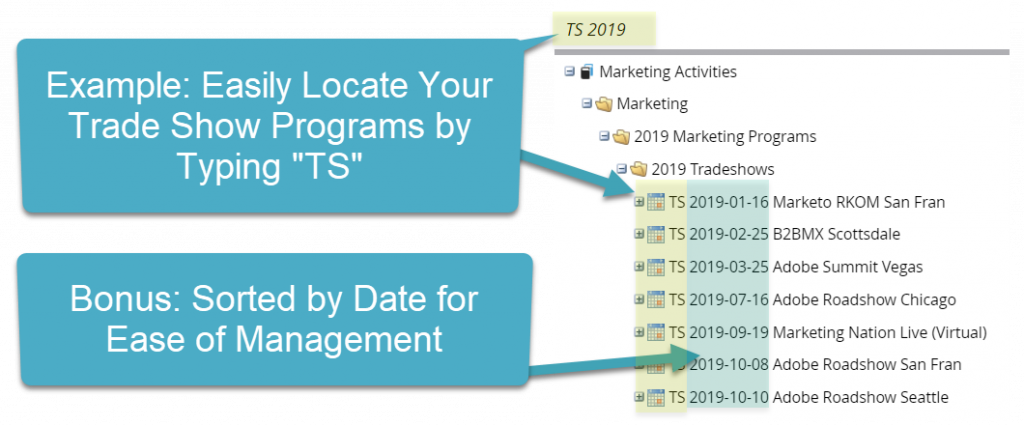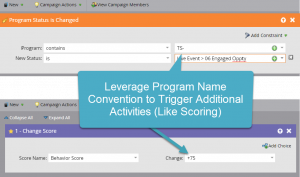A poor marketing naming convention strategy is kind of like an 7-year old trying to make a cake–eventually things are going to get messy. This might be fun in the confines of your kitchen but messiness has no place in marketing automation. Naming inconsistencies reduce reporting effectiveness, cause marketing inefficiencies and reduce marketing automation power.
For example, did Joe name last year’s annual event “Joe’s Texas Event 2020” while Karen named this year’s “Trade show-Dec-Dallas?” This kind of naming will drive marketers nuts when it comes time for analysis.
Forget about analysis for second. What about trying to find these marketing activities in the marketing automation platform like Marketo? Was it named “trade show”or “event”? Is the event in a month letter format (Oct) or month digit format (10). Lastly, marketers lose flexibility to trigger different activities based on the name.
A few inconsistent examples:
- Event_Oct_2014_Europe
- Trade show, November 1, 2020
- Gus’s tradeshow-Speaking 2020-10
- Tradeshow NYC, 2020
- Minn Executive Conference, 10/1/2020
Why is Naming Important?
I’ll get to the actual naming convention strategy later in the article but here are a few reasons to consider adopting a consistent naming process.
1) Get Better Reporting Insights
Consistent program names make analysis and comparison easier. For the spreadsheet whizzes, consistent naming enables advanced filtering to gain custom insights.
Without a strong naming convention
Comparing events and website assets is very difficult as marketing activities are blended together. Add in PPC, sponsorship and other channels and analysis can quickly get out of hand.
With a naming convention
You can easily distinguish between marketing activities and compare results. Answer questions like:
- How did our events perform vs our webinars?
- Which website assets are being downloaded most?
Answering these questions with the previous model will give you a headache when you are trying to compare hundreds of programs.

2) Streamline Management within Marketo and Other MAPs
No need to get frustrated trying to figure out if the program is called “Tradeshow” or Trade Show.” Use the naming convention to cut down management time by easily finding and sorting assets.
Marketo’s sort order begins with special characters, then numbers, and then letters. This means that special characters used before numbers and letters will bring those items to the top of the Navigation tree in Marketo.

3) Build More Powerful Programs
When names are standardized, marketers gain the flexibility to build more powerful global programs by leveraging the consistent naming. A few trigger examples:
- If a lead clicks a link with a program starting with “NUR-Early,” then transition the lead to the mid-stage nurturing track.
- If a lead reaches success in a program that includes “-WP,” also add the lead to the Whitepaper Asset program.
- If a lead’s Last Interesting Moment contains “-Trial,” boost the lead’s score by +75 points.

Note: As with anything in Marketo, there are many ways to accomplish the above. You may or may not want to use triggers like above but the key is flexibility to give yourself options for future scale.
Get Your Names Right – The Conventions
The below convention is one of several you can adopt within your organization for program level naming. These conventions enable organizations to quickly search for similar assets, programs, etc. while allowing for users to sort programs chronologically.
The Program Convention………….
[Abbreviated Program Type]-[4-digit Year]-[2-digit Month]-[2-digit date]-[Program Description]-[Location or Content Type][/message]
Optional for larger organization is to add the program manager’s initials at the the end. You can also add other items like target audience if applicable.
Examples:
WB-2020-10-15-The-ABCs-of-Marketing
A webinar in October on the The ABCs of Marketing
WS-2020-10-Best-Practices-WP
Best Practices Whitepaper published on the website on Oct 23, 2020. Note that the day of month is not included as that level of granularity is probably not needed for a content asset. Of course, if you want it, add it in.
RS-2020-12-10-Get-Productive-Dallas
Roadshow in Dallas in December 2020
OA-2020-12-Tech-Target-Nurturing-Success-CS
OA-2020-Q4-Tech-Target-Nurturing-Success-CS
OA-2020-Q4-Tech-Target
Here are three approaches to online advertising. This is a case study on Nurturing Success that is promoted via the Tech Target Online Advertising channel in December. If you advertise on a quarterly basis, you could elect to change the month format (10) to a quarterly format (Q4). If you go this route, ensure all OA programs leverage this naming.
Advanced. Are we tracking Content or Sources? Whew, this hotly debated question deserves its own post. The third option involves giving two programs successes–the Tech Target program and a separate Case Study content program. This approach lets you track Source and Content separately while also reducing the number of programs (One generic Tech Target program vs many for every asset offered via Tech Target). I’ve seen numerous approaches work here and it all depends on your organization’s reporting needs. Integration with a lead source management system is also key.
Other Marketo Naming Convention Considerations
So what’s up with the dashes?
Dashes are optional but I like to use them in conventions. Why? The first reason is consistency for lead source URL parameters. When these values are used as part of URL parameters that feed Lead Source data into the system, a dash or underscore is needed (blank spaces in links can sometimes wreak havoc). The second reason is searchability. It’s an easier (and more accurate) to type “CS-” and find all your case studies. A pure “CS” search would pull up other asses like “The ABCs of Marketing.”

Why the funky date format?
Get your brain thinking a little differently. Americans like to use the 12-22-2020 format while Europeans like to use the 22-12-2020 format. So why use this 2020-12-22 format? One word–sorting. By using the 2020-12-22 format, all of your programs will automatically put themselves in chronological order with no extra work by you.
Don’t Let Your Names Avalanche out of Control
To summarize, make sure to chose a naming convention that meets your organization’s goals. The biggest piece of advice I can give—be consistent.


